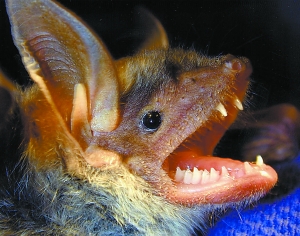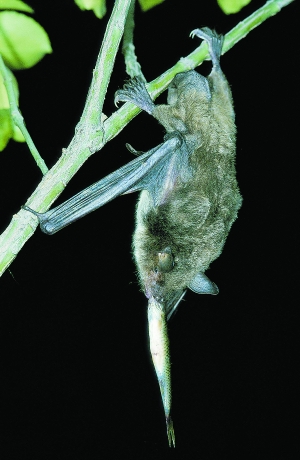Discover the species of bat that catch ... fish
People often only know two common bats are bats that eat insects and bats that specialize in sucking blood called the Dracula bat (Vampire bat). But the existence of bats that like to eat fish and know how to catch fish is very little known.
History of long-fingered bat research - fishing bat
In Fangshan District, Beijing, China, scientists found a large bat cave estimated at about 3,000 bats. They are considered to be the only fish bats living in Asia.
In 1936, a Harvard University professor named Allen Museum received a very special bat model. This bat is quite small in size compared to other normal bats but they have quite large claws, curled up like a hook and very sharp.
Allen named this bat a ' long-fingered bat ' and he noted that this is a rare bat and has a slightly strange claw.

Bats only eat insects mainly
According to the principle of evolution in animals, every unique part of the body is related to a unique unique feature. Allen began to explore the strange characteristics of the bat specimen and doubted that they used these claws to catch . fish, a type of food uncommon in the bat world.
Allan wanted to do this strange bat surgery to find traces of fish in his stomach. However, he had only one specimen, so he could not fulfill that intention. He searched for fish traces in their droppings but failed.
In such a difficult situation, he retained the speculation that the long-fingered bats were the ones that could eat fish and the only basis for his belief in that was the unusual claws.
Go to modern discoveries
70 years later, scientists found the first evidence of the existence of fish-eating bats. It's like Sonaro's bat living on a small island in western Mexico, in dense forests.

Bats catch fish
Two bat specimens in Mexico also have long and sharp claws, their toes are very long and the tibia is distinctly different from other normal bats. Not only are they long, they also have integrated points with very high wing membranes that make them waterproof.
In 2003, Spanish scientists also discovered a species of bat that catches fish in Europe. This bat has a weight of about 9g and a body length of 42 mm - quite small in size compared to normal bats.
Thanks to the small radio equipment, scientists from the Basque National University in Bilbao recorded the image of their fishing process. These bats fly low on the water and catch fish with their claws.
This European long-eared bat often feeds in wetlands, canals and lakes along the Mediterranean coast of Morocco, Algeria, Lenaon, Jordan and Iran and Europe.
Bats found in China also have a coincidence with bats found in Europe. Chinese scientists have come to the bat cave in Phong Son district since 2002. When studying the first bat manure samples, they found no trace of bones or fish scales but found only traces of insects.
A month later returned to the cave to continue collecting stool samples at the time of the dry season in the hope that the bats would have a better chance of finding fish in a large lake nearby. And this time they were lucky. They found fish scales in some stool samples. The analysis showed that the bat had eaten at least 3 fish. But they still do not know how to catch their fish.
Bats are not able to come into contact with water. If they fall into the water they may die. Species of feeding bats at night rely on the ability to emit ultrasound to determine the location of the prey. But Chinese scientists found that bats living in Bat Son bats emit very limited ultrasonic waves. It can only detect obstructions at a short distance and only recognize water when it is 3 mm above the water surface.

A Chinese scientist at the bat cave catches fish
Room Son, Beijing
After a long time of understanding, the mystery was decoded. It turned out that these bats took advantage of small fish of about 5 cm in size that often jumped out of the water to try to catch them. The experiment reproduced in the laboratory also proved it. Bats in Phong Son can use a claw to catch a 5-10 cm long fish.
However, scientists believe that the ancestors of true fish-eating bats didn't have to eat fish from the beginning. Maybe they evolved from an insect-eating bat . Their ancestors often catch insects living on water or insects that eat plankton. And in the process, they caught small fish jumping out of the water or swimming close to the water and starting to convert their tastes to smaller fish with more nutrients.
- Phillipines fishermen catch a giant
- The most bizarre fish species on the planet
- Discovered species of bat that catch fish
- Amazed fish that know how to catch prey on land
- Discover two new fry fish species in Vietnam
- Catch 3 rare moon fish in the same day
- Bats know how to swim and catch fish
- Catch living giant paddle fish in Taiwan
- Nghe An: Catch the giant Moon fish 400kg
- Discover new, extremely rare fish
- 10 most expensive fishes in the world
- Surprised with fish-eating spiders
 Animal 'suffering' after hibernation
Animal 'suffering' after hibernation Why do goats climb well?
Why do goats climb well? Scientists were surprised to see chimpanzees eating turtles
Scientists were surprised to see chimpanzees eating turtles Giant catfish died deadly due to drought in Thailand
Giant catfish died deadly due to drought in Thailand